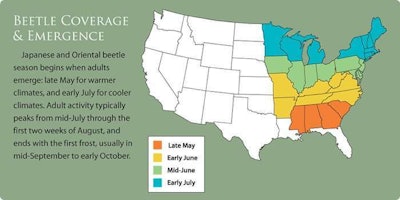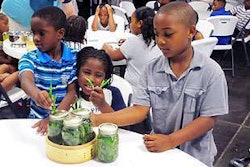
Since 1916, Japanese beetles have been the bane of many Eastern and Upper Midwest landscapers.
The Japanese beetle first arrived after riding on a container of ornamental plants from Japan.
There are a variety of methods to treat the pest, but there are a few myths that need to be addressed first.
According to Dr. Michael Klein, an entomologist at the USDA’s Agricultural Research Service lab, pheromone traps are the most effect and environmentally friendly method of combating Japanese beetles.
Klein offers three “myth busters” to help landscapers fight against Japanese beetles:
Myth #1: Traps lure Japanese beetles from miles around.
The facts: Most attractants lure beetles from no more than 200 yards, Klein says. The beetles, however, are strong fliers and travel several miles, touching down at random intervals to see what’s available to eat. If a yard looks attractive, they will come in for a meal – unless a trap is set to intercept them. The traps only lure beetles that are already near the yard. One type of setting where traps could be an issue is around a golf course or large turf area, but not in the average yard.
Myth #2: Traps make the problem worse by luring more beetles than they catch.
The facts: This is the biggest misconception in beetle history. The problem occurs when traps are placed incorrectly. If placed next to a rose bush, beetles will be attracted to that area, and may land on the roses rather than in the trap.
Dr. Klein offers these tips for using Japanese beetle traps effectively:
- Trap placement is critical. Don’t place the traps next to ornamental plants. Set traps about 30 feet from tasty plants to lure the beetles away. It’s best to place them next to a non-flowering tree or shrub, such as a pine tree or boxwood, which is not attractive to the beetles.
- Enlist neighbors to battle the beetles, too. Traps are effective in one yard alone, but when neighbors band together and put out traps in their yards, the overall beetle numbers are greatly reduced. Consider it a “neighborhood watch” for garden invaders.
Myth #3: Pesticides are safe to use on Japanese beetles.
The facts: Insecticides work on adult beetles, but they also kill beneficial pollinators, like bees. Traps offer safe and “green” alternatives to chemical sprays targeting these bugs.
Information provided by the Rescue!









